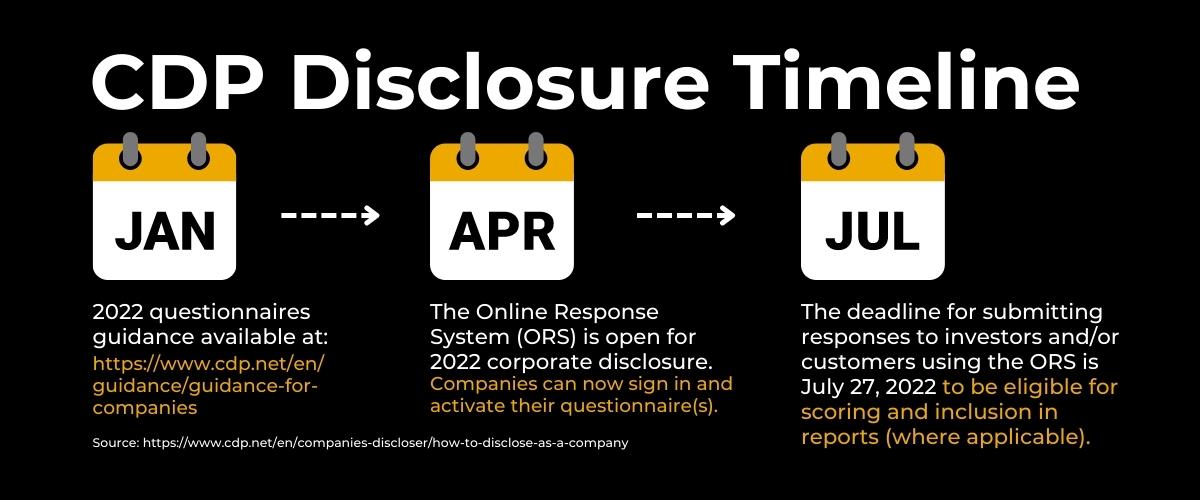News and Insights
The Disclosure Journey through CDP
April 26, 2022
Every year, hundreds of the world’s largest financial institutions use CDP disclosure to request comparable, decision-useful data from companies by way of their sector-specific, Taskforce on Climate-related Financial Disclosures (TCFD)-aligned questionnaires. This year, nearly 700 investors with more than $130 trillion in assets are making the request. CDP transforms TCFD recommendations into actionable metrics, bolstering the actions of companies around the world to ensure they are moving forward as effectively as possible to a) ensure success in the low carbon economy, and b) ward off the most catastrophic effects of climate change before it’s too late.
CDP data is useful for advancing engagement between corporations and their investors and purchasing partners, as well as for supporting efforts in reporting. CDP leverages data to identify and communicate sustainability trends.
It’s Time to Start Your CDP Response
This month, the CDP online portal opens and companies that have received communications from CDP can input data into their questionnaires. CDP allocates three months to transfer your company’s data into the platform for a score.

CDP’s questionnaires request information on topics including governance, strategy, risks and opportunities, metrics and targets, energy, carbon pricing and biodiversity. There are also questionnaires specific to water and forests.
CDP is one way to ensure that your company’s climate information, including emissions data, is communicated to key stakeholders. The benefits of disclosing through CDP are numerous and include:
- Aligning your sustainability strategy with the recommendations of the TCFD (More information on this alignment can be found here.)
- Benchmarking your organization’s sustainability efforts against other companies to drive progress internally and boost your reputation
- Enhancing communication with stakeholders, including the financial community
- Futureproofing against potential regulations (and preparing for demands from the SEC)
Further, responding to the CDP request is an important component of any comprehensive sustainability program, which might also include SASB- and GRI-aligned reporting. CDP scores allow you to understand where there is room for improvement in your climate performance.
What Kind of Trends Does CDP Data Illustrate?
A recent analysis has shown that about 4,000 companies (out of the 13,000 that submitted responses in 2021) have a low-carbon transition plan. Worse, only 135 of those 13,000 companies disclosed information on the 24 indicators CDP requires to claim credibility for a plan. One aim of CDP is to facilitate benchmarking among companies to drive progress, so this insight – while disappointing – is crucial considering the most recent IPCC update. It should also serve as a reminder to follow certain best practices when developing your CDP disclosure:
- Utilize CDP’s publicly available resources such as Reporting Guidance to meet the criteria for each question. (When you are missing information included in the guidance, then you know to revisit this in your operations.)
- Be robust in your responses and answer in a way that is honest and specific to your company.
- Invest in climate-related scenario analysis for an in-depth understanding of how your company might fare in different future states.
Securities and Exchange Commission (SEC) News
The SEC recently proposed a rule change that would give investors better insight into climate-related risks and greater leverage in advocating for meaningful change. It would also hold companies to account for their role in the climate crisis. If the plan is enacted, it will create a framework for all publicly traded companies to provide information about climate risks in annual reports and statements. The plan would require companies to report on Scope 1, 2, and 3 emissions. (The Environmental Protection Agency has a helpful visual from the GHG Protocol of what constitutes emissions in each Scope.) Scope 3 emissions are those that come from an organization’s suppliers, leased assets and incidental operations – often the majority of a business’s carbon footprint.
Companies that disclose to CDP or have been preparing to start disclosing to CDP are already ready. The SEC specifically recognizes CDP as fully aligned with the rule thanks to its incorporation of the TCFD framework. If you want to start the CDP reporting journey or strengthen your disclosures, now is the time.
Work With Us
CDP has been operating for more than 20 years and has grown in renown. Questionnaires are continuously updated to provide stakeholders with the most relevant and material information. This is important to remember as responding each year requires a fresh look at your company’s data and processes.
The Global Sustainability & Social Impact team at FINN Partners has expertise in CDP disclosure and can provide support in several ways, including reviewing your responses and flagging improvement areas, as well as discussing your submission following score release. If you’re exploring other ways to strengthen your reporting, we invite you to connect with us.
-
TAGS:
- Sustainability & ESG